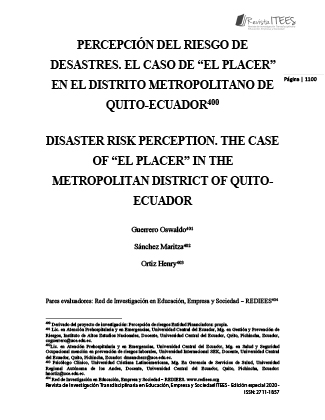LVI. DISASTER RISK PERCEPTION. THE CASE OF “EL PLACER” IN THE METROPOLITAN DISTRICT OF QUITOECUADOR
##plugins.themes.bootstrap3.article.main##
Abstract
The perception of disaster risk of the population of "El Placer" in Quito-Ecuador, its
relationship with economic income and the availability of their own means to face them are
what motivated this research. Methodology: qualitative-quantitative, non-experimental,
cross-sectional, exploratory in nature to 898 people to obtain the following results: the
sample is distributed in 60% men and 40% women, 71% between 25-54 years where 74%
receives income equal to or greater than $ 800. Seismic movements, landslides and crime are
perceived as threats of “high” concern and that could trigger a disaster, they consider that
their level of risk will increase over time mainly due to the intervention of the same
community. Only 20% of the sample think that they have the basic means to initially face an
adverse event and have an emergency financial fund, family emergency plan and / or
emergency backpack. When correlating economic income with the means to face an event,
it was found that there is a relationship between the variables, mainly with the economic
fund. Conclusions: risk perception is a fundamental tool for community participation in
disaster risk management processes, be these: preventive, reactive and / or corrective, the
inadequate perception of the levels of disaster risk to which it is exposed a community, can
diminish the capacities to respond to the materialization of threats.
Download Statistics
##plugins.themes.bootstrap3.article.details##
perception, risks, disasters, risks, emergencies.
Caballero Lopez, J. E. (09 de 2009). http://scielo.isciii.es. Obtenido de
http://scielo.isciii.es/pdf/mesetra/v55n216/revision.pdf
Center for Research on the Epidemology of Disasters CRED. (2017). UNDRR. Recuperado
el 13 de abril de 2020, de https://eird.org/americas/docs/perdidas-economicaspobreza-y-desatres.pdf
Herrera, I. (2016). Flood Resilience Portal. (I. Herrea, Ed.) Recuperado el 23 de febrero de
2020, de
http://repo.floodalliance.net/jspui/bitstream/44111/2096/1/1351466201642710318%
20%285%29.pdf
John, A. (2016). Normas Basicas de Higiene del Entorno en la atención sanitaria. India:
Organizacion Mundial de la Salud. Obtenido de
http://apps.who.int/iris/bitstream/handle/10665/246209/9789243547237-
spa.pdf;jsessionid=98A5D7C69806F077F4D7F5B862DCA0BB?sequence=1
Municipio de Quito. (2012). Municipio del Distrito Metropolitano de Quito. Recuperado el
febrero de 2020, de
https://www.quito.gob.ec/documents/Plan_Metropolitano_desarrollo_2012-
2022.pdf
Narváez, L., Lavell, A., & Pérez Ortega, G. (2009). Comunidad Andina. Recuperado el 23
de marzo de 2020, de
http://www.comunidadandina.org/StaticFiles/Temas/AtencionPrevencionDesastres/
EJET1Procesos.pdf
Secretaría Técnica de Gestión de Riesgos. (2012). Ecuador listo y solidario. Recuperado el
febrero de 2020, de https://www.ecuadorlistoysolidario.gob.ec/plan-familiar-deemergencia/#





